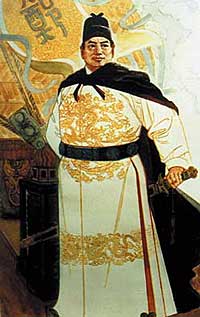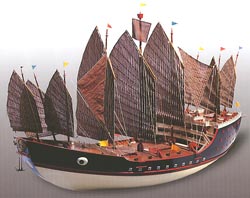The Legend
Zheng He, the legend |
| © Zheng He institute |
The most famous maritime explorer in Chinese history is Zheng He, born in Kunyang, Yunnan (present-day Jinning County, Kunming) 1371 AD, the fourth year of the Hongwu reign period of the Ming Dynasty. He was originally surnamed Ma. and later known as San Bao (Three Treasures). Zheng He was captured by Ming Dynasty forces during their defeat of the remnants of the Yuan Dynasty in Yunnan 1381 ADand was taken to Nanjing, where he was made an eunuch in the imperial service. He was later sent to Beiping (present-day Beijing) to serve in the palace of Zhu Di, the Prince of Yan, fourth son of the Ming Emperor. In the palace, He´s brilliance and loyalty won him Zhu Di´s trust. As a result, the prince choose Zheng He to serve as his personal bodyguard during his quest to become emperor. It was during this period that Zheng He´s genius and leadership abilities became apparent. For four years, Zheng He went through fire and water at the side of Prince Zhu Di, accompanying him on countless campaigns and battles throughout China
He rose in the ranks, became an officer, and when Prince Zhu Di became emperor He´ was appointed Grand Eunuch in 1404. Zheng He became a legend in his lifetime, known as the Grand Eunuch, and commanded seven voyages of exploration in 28 years from 1403 to 1433 in huge, many-masted ships.
300 ships with 28.000 men
In 1405 the largest sea fleet the world had ever known set off from Taicang in Jiangsu Province. In He´s first voyage 1405 - 1407 he set sail with a fleet of over 300 ships and more than 28,000 men. Many "academics" from all science disciplines whose role was to explore what other nations had to offer was with him on this voyage. 62 of his ships were over 100 m long and carried a huge cargo for the exchange of gifts with other empires: silk, porcelain, gold, silverware, copper, various utensils, iron implements and cotton goods. The largest vessel had a total length of 130 m, a width of 60 m, carried nine masts and was crewed by 500 men.
Zheng He also later sailed to India, Sri Lanka, Arabia, E Africa, and Egypt. On his fourth voyage (1413-15), Zheng returned with envoys from 30 foreign states who rendered homage to the emperor and sailed home on his sixth voyage (1421-23). Although China returned to an isolationist policy after the emperor´s death (1424), Zheng made one last voyage (1431-33).
Discovered AmericaA controversial theory hypothesis that the New World was discovered by Zheng during his 1420s voyage, some 70 years before Columbus. The British author Gavin Menzies, a retired British submarine commander, means in his book 1421: The Year China Discovered the World that the Chinese beat the Europeans (Columbus) to the New World by decades, if not centuries.